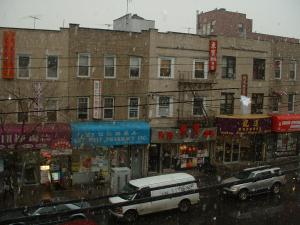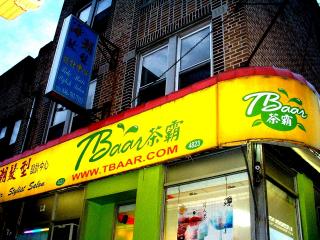
BROOKLYN, N.Y. – Board the N train at the Canal Street subway station and a 20-minute ride over the Manhattan Bridge (and a maze of underground tunnels) takes one to 8th Avenue in Brooklyn – the gateway to New York City’s lesser-known Chinatown.
Territorially speaking, after Manhattan and Queens', it’s the smallest Chinese enclave, but it is by no means, any less Chinese. Locked between 62nd and 48th streets, this 16-block bustling stretch is predominantly populated by the Cantonese community.
No quarter in this teeming metropolis of over 8 million, is ever quite quiet. This area is no exception. However, its structure, unlike that of Manhattan’s labyrinthine, Chinatown, is puzzlingly simple.
It is this urban design, which gives it the illusion of space. Ironically, it also perhaps, takes away from it the aura of a glitzy, gypsy bazaar, which is the hallmark of its more famous cousin, on the other side of the Hudson. Boxy, store-top apartments lend the landscape a dirty-brown tint.
This isn’t an impression created solely by its uncomplicated layout; the businesses themselves contribute to the effect.
While Manhattan’s Chinatown is a carnival of counterfeit Cartier and Channel, Brooklyn’s celebrates genuine, everyday household goods – from buckets to wall brackets.
This Chinatown is as Chinese as it gets. It’s also very cheap. The “Made in China” label has a ring of special authenticity to it, but flashy, fake designer bags and bling are not seen here. Instead, one’s likely to run into a one-size-fits-all bathroom slipper in a “99 Cent” store. This is the biggest reason for this Chinatown’s relative obscurity and its failure to attract throngs of tourists.
A row of eateries, mom-and-pop grocery stores, hairdressers, Buddhist temples, Internet cafés and offices of community organizations, flank the two-way boulevard. At any time of the day, the smell of stir-fry wafts out of greasy dumpling houses. Bakeries selling bean-filled pastries, steamed breads, buns, punctuate every block.
Every few steps, there’s a Chinese or Vietnamese restaurant. Most offer daring ethnic dishes (daring, to those unused to authentic Chinese cuisine, that is.) Embedded in their regular menus of an assortment of soups, fried rice and lo-mien, are preparations of pig’s ears, fried frog’s legs, spicy chicken claws, ox-tongues, and fish head among others.
But these aren’t magnets for the savvy shopper, on the lookout for a $50 knockoff of a Louis Vuitton suitcase or a $15 Christian Dior bracelet, and even a $25 bottle of real Hugo Boss perfume.
The sights here, humdrum as they may be, offer a window into the lives of the average East Asian immigrant, earning by the sweat of their brows. By the curb, a double-parked car idles, as its driver awaits the return of its passenger. On a lunch break, a knot of Chinese chefs, huddle around a sidewalk cellar and eat noodles out of Styrofoam boxes. In a hurry to get to his destination, a porter in a grimy uniform jostles past with his delivery trolley.
A mother, behind a baby’s stroller, delicately negotiates the crowd as she balances her plastic shopping bags on its handles. An elderly woman, with a face deeply wrinkled with age, stands at a curb-cut, handing out Falun Gong flyers to passersby. Small groups of teens, with silky, straightened hair streaked with blonde or auburn are the only ones in this neighborhood, usually seen to saunter by without any obvious baggage.
If the Chinatown on Canal Street is defined by its bling factor, the one on 8th Avenue is identifiable by its cornucopia of Asian groceries. Bok choy, lotus roots, mung-bean sprouts, Chinese cabbage, and bamboo shoots are sold fresh on makeshift wooden stands on the pavement. Fishmongers strut out in the open, their wide (and exotic) varieties of seafood in water-filled plastic tubs.
If one doesn’t mind watching out for the occasional crab scurrying sideways across a lettuce-splattered footpath, shopping for fish can be a joy in Brooklyn’s Chinatown. A pound of fresh pink salmon goes for as little as $5.99. Two whole porgy cost under $7. Fresh-off-the-boat crabs can sell for well under $10.
No worthy Chinese locality is complete without a Hong Kong Supermarket.The Chinese equivalent of the American Safeway, this chain store specializes in East Asian foodstuff – everything from Japanese nori (seaweed) to bottled kimchi (hot and spicy Korean coleslaw) to a sack of Thai sticky rice.
At the junction of 8th Avenue and 53rd Street is “Dumpling House.” Opened in the summer of 2009, it’s the area’s newest snack place, and hence, possibly, the cleanest. Its top picks are chicken, pork, shrimp, and veggie dumplings, either served as pot stickers (pan-fried on side and steamed on the other) or fully steamed.
It’s owned and run by 28-year-old Ying Zhao, who moved to the United States eight years ago, from the southeastern province of Fujian. Zhao has difficulty speaking English, but understands it just enough to take orders from non-Chinese speaking customers. While she handles the front end, her father whips up the dumplings, and an aunt pitches in with small chores.
 At 4823 8th Avenue, stands a little shop called T-Baar, which doesn’t vibrate with the hiss and the whoosh of commercial coffee making. Home-use blenders, a few kitchen knives, and shakers take the place of industrial espresso machines, cappuccino makers, and milk frothers.
At 4823 8th Avenue, stands a little shop called T-Baar, which doesn’t vibrate with the hiss and the whoosh of commercial coffee making. Home-use blenders, a few kitchen knives, and shakers take the place of industrial espresso machines, cappuccino makers, and milk frothers.
This is just one of a dozen places in the area that serves “bubble tea.”
Even without the artificial chill of air-conditioning, it exudes an innate coolness that coffee shops simply don’t. Maybe this is why: Exclusive tea varieties are colorfully described, often, with the adjective “soothing.” (Think, the classic British expression, “how about a nice cup of tea?”) While coffee blends are associated with the word “strong.”
The Chinese have been drinking tea for 5,000 years. That they are ace innovators of this drink is therefore, hardly surprising. In the 1980s, a tea-stand owner in Taiwan brewed a concoction that took the global East Asian beverage market by storm, his liquid tempest was bubble tea. Today, it’s a hip favorite among East Asians, as well as the geeks, the chic, and the thirsty of all other ethnicities.
It’s a sweet and serene non-alcoholic tea drink. Translucent tapioca globules that bounce at the bottom of the glass, give the drink its name. Soft and chewy, they impart a certain friskiness and freshness that’s hard to match. Not saccharine (unless of course, by choice), it’s pleasantly sweetened by sugar syrup or honey.
It’s available in many exciting flavors – watermelon, papaya, honeydew, banana, strawberry, almond, taro, coconut, etc. – the flavorings created by powdered flavors and sometimes, by crushed fresh fruits. The tea types used are green, black, or jasmine, and bubble tea is great with or without milk.
Except during the daily evening rush that begins around 4 p.m. and peters off by 8 p.m., there’s satisfactory elbow room on the sidewalk for walkers – a luxury seldom enjoyed in the bigger Chinatown. On certain weeknights, Chinese bus companies drop off its load of the elderly at designated stops along 8th Avenue. Some return home from a gambling excursion and some, from an out-of-town business trip. Well past night, a drunk staggers out of a bar yelling obscenities in … Foochowese?
